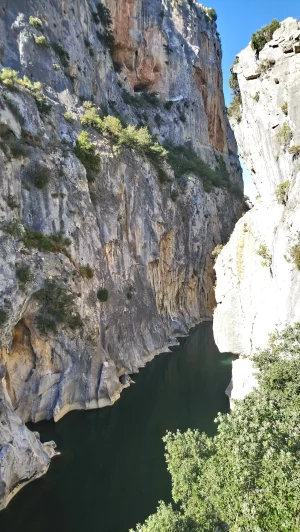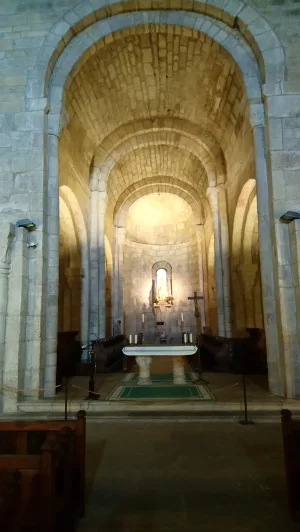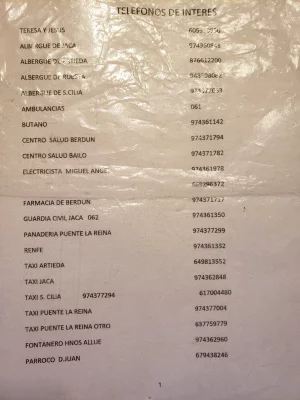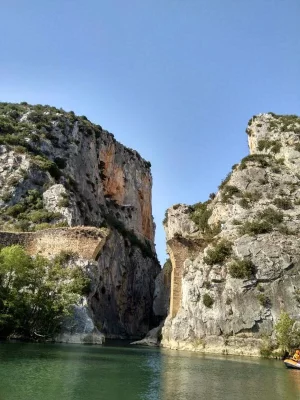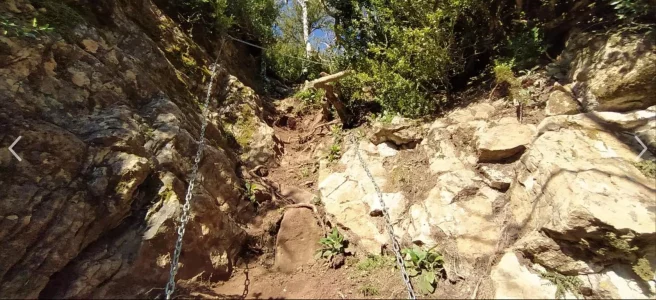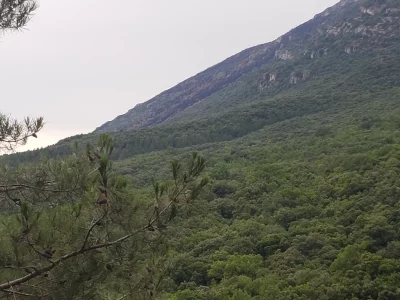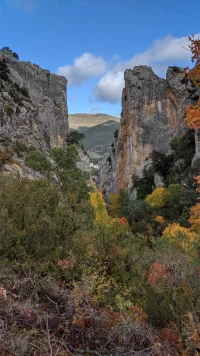I have had several conversations on various threads about these options, and I thought I’d put it all in one place for anyone who is contemplating the same thing or who might be enticed to contemplate the same thing once they see how amazing these destinations are.
I also want to preface this by saying that I know that there are many who prefer to stick to the camino and don’t have any interest in the detours that I typically come up with. That’s fine, I get that, but for anyone who is more like me…. here goes.
From Ruesta on the Aragonés, the next official Camino Aragonés destination is Sangüesa, and the Camino passes through the town of Undúes de Lerda, for a total stage of about 24 km with about 600 m elevation gain. A fairly manageable stage for many people.
North of the Camino near Undúes de Lerda are two important historical sites - the Castillo de Javier, and the Monasterio de Leyre. Wikiloc showed me how easy it is to branch off and visit them both.
From Ruesta to Javier Castle, it is about 18 km, shown on this wikiloc track (it leaves the camino somewhere after Undúes de Lerda). The track goes all the way back to Sangüesa from the Castle, so only the first part of the track will be needed to get to the castle.
From Javier Castle to the monastery, it is about 11 or 12 km.
Some would do that 30 km in one day (like the younger me); others would want to do it in two days to have time to visit the castle on the day from Ruesta and then have plenty of time to visit the Monastery the next day. I have visited the monastery twice and can say is a 5 star attraction, at least for those who like ancient churches. I really want to WALK there, though!
From the monastery, it’s easy to either take a trail which takes you back to the Aragonés at Sangüesa, or if you are like me and have already been in Sangüesa, you can go directly from the monastery to the entrance to the Foz de Lumbier.
Here’s a trail that would go from monastery to Sangüesa back through the Javier Castle.
Monastery to Sangüesa would be about 17 km. Then you decide whether to take the Lumbier alternative or not.
If you don’t care about going through Sangüesa, you can walk from the Monastery directly to the entrance to the Foz de Lumbier in two ways.
The difficult way goes up across a ridge, and then down to the entrance to the tunnel.
That is about 17 km and involves a difficult climb with chains, total elevation gain about 1100 m.
The route that @Vacajoe (I think) and others have walked goes from the Monastery through Yesa, and through Liedena, and then on to the start of the gorge trail. That route is here:
That would be about 18 km from the Monastery, through the gorge, and to the town of Lumbier. The tracks I linked to went further on to Monreal (for a total of about 37), which my current self would probably not do, but a stop in Lumbier is recommended by many on the forum anyway.
Once in Lumbier, you will rejoin the official camino at some spot before Izco and would have a 23 km day from Lumbier to Monreal.
One other thing to throw out — if you haven’t been to Sangüesa (and it does have a nice Romanesque portal on its church), you can easily get from the monastery to Sangüesa (17 km) and then 10 more to Lumbier. That means that going from Leyre through Sangüesa would be a 27 km day to Lumbier, while the off-camino route would be 18.
And one last thing - there is a ridge trail that goes from Leyre to Lumbier but does not go through the gorge.
Choices, choices! I am putting all of this into one post, more for myself than anything so that when I am actually ready to contemplate these choices, all of the information will be in one place. Right now I am in the dreaming stage, but this is my hope for 2025!
Thanks to @Vacajoe and others for their help focusing me on this alternative. I would love to hear from others with different ideas about this segment!
I also want to preface this by saying that I know that there are many who prefer to stick to the camino and don’t have any interest in the detours that I typically come up with. That’s fine, I get that, but for anyone who is more like me…. here goes.
From Ruesta on the Aragonés, the next official Camino Aragonés destination is Sangüesa, and the Camino passes through the town of Undúes de Lerda, for a total stage of about 24 km with about 600 m elevation gain. A fairly manageable stage for many people.
North of the Camino near Undúes de Lerda are two important historical sites - the Castillo de Javier, and the Monasterio de Leyre. Wikiloc showed me how easy it is to branch off and visit them both.
From Ruesta to Javier Castle, it is about 18 km, shown on this wikiloc track (it leaves the camino somewhere after Undúes de Lerda). The track goes all the way back to Sangüesa from the Castle, so only the first part of the track will be needed to get to the castle.
From Javier Castle to the monastery, it is about 11 or 12 km.
Some would do that 30 km in one day (like the younger me); others would want to do it in two days to have time to visit the castle on the day from Ruesta and then have plenty of time to visit the Monastery the next day. I have visited the monastery twice and can say is a 5 star attraction, at least for those who like ancient churches. I really want to WALK there, though!
From the monastery, it’s easy to either take a trail which takes you back to the Aragonés at Sangüesa, or if you are like me and have already been in Sangüesa, you can go directly from the monastery to the entrance to the Foz de Lumbier.
Here’s a trail that would go from monastery to Sangüesa back through the Javier Castle.
Monastery to Sangüesa would be about 17 km. Then you decide whether to take the Lumbier alternative or not.
If you don’t care about going through Sangüesa, you can walk from the Monastery directly to the entrance to the Foz de Lumbier in two ways.
The difficult way goes up across a ridge, and then down to the entrance to the tunnel.
That is about 17 km and involves a difficult climb with chains, total elevation gain about 1100 m.
The route that @Vacajoe (I think) and others have walked goes from the Monastery through Yesa, and through Liedena, and then on to the start of the gorge trail. That route is here:
That would be about 18 km from the Monastery, through the gorge, and to the town of Lumbier. The tracks I linked to went further on to Monreal (for a total of about 37), which my current self would probably not do, but a stop in Lumbier is recommended by many on the forum anyway.
Once in Lumbier, you will rejoin the official camino at some spot before Izco and would have a 23 km day from Lumbier to Monreal.
One other thing to throw out — if you haven’t been to Sangüesa (and it does have a nice Romanesque portal on its church), you can easily get from the monastery to Sangüesa (17 km) and then 10 more to Lumbier. That means that going from Leyre through Sangüesa would be a 27 km day to Lumbier, while the off-camino route would be 18.
And one last thing - there is a ridge trail that goes from Leyre to Lumbier but does not go through the gorge.
Choices, choices! I am putting all of this into one post, more for myself than anything so that when I am actually ready to contemplate these choices, all of the information will be in one place. Right now I am in the dreaming stage, but this is my hope for 2025!
Thanks to @Vacajoe and others for their help focusing me on this alternative. I would love to hear from others with different ideas about this segment!







